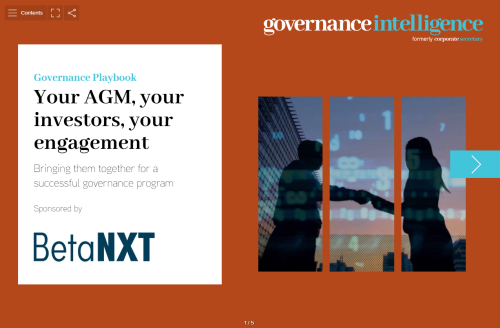Shareholder engagement should be top of mind for public companies now more than ever before – and getting it right requires careful work by in-house governance and other teams.
The heightened need for engagement is due to a combination of factors including the lasting effects of the pandemic and resulting economic issues such as inflation and market volatility, the increased focus on ESG issues, growing numbers of shareholder proposals and renewed efforts by shareholder activists. Engagement, if done well, puts the company in a better position if an activist comes calling or if it receives a shareholder proposal for the next AGM.
There are essentially two sides to shareholder engagement. The first is the work done by the investor relations team with buy-side analysts and CFO and CEO conversations with analysts during quarterly earnings calls and at investor conferences. The other side, on which this article is focused, involves the interactions between the legal or corporate secretary group at a public company and the governance group at the top 10 fund managers that own stock in the company and vote a significant portion of the shares at its AGM. The company’s conversations with the governance group of the funds can also include key board members.
Conversations with key shareholders are beneficial for both the company and investors. These discussions give board members the opportunity to hear directly from investors on issues such as the environment, diversity and inclusion, executive compensation and governance. It also gives the board the opportunity to provide information to investors regarding the company’s vision and long-term strategy.
It is important to focus on the following considerations before, during and after embarking on the engagement process to ensure these engagement discussions are as effective and successful as possible.
- Do your (proxy) homework
Directors generally don’t get involved in the preparation of the company’s proxy statement, but it provides a wealth of information for investors. Historically, the proxy statement was viewed primarily as a disclosure document required to comply with SEC rules. But it has evolved over the past 10 to 15 years into the primary means of communicating with shareholders.
If drafted effectively, the proxy statement can provide the necessary transparency investors seek regarding the company, board oversight and management. It can also provide an opportunity to showcase what the company has done and is doing in critical areas such as ESG and long-term strategy.
It’s important to review the proxy statement’s portrayal of the company and other disclosures, such as how key initiatives appear on the company’s website, before starting engagement as this information generally forms the starting point for discussions. Before having a conversation with key investors, it is important to know what issues or topics are important to them, how the company stacks up and the investor’s position on those matters.
It is also important to know whether the shareholder makes voting decisions based on recommendations from proxy advisory firms such as ISS and Glass Lewis or whether it considers the proxy adviser firm recommendations and makes its own decisions on proposals. This is often crucial in the engagement decision as it will determine the focus of the conversation.
- Have a process
It is helpful to obtain or provide an agenda in advance of engagement discussions so that you can carefully select the engagement team members who will attend the meeting. Attendees can be members of the governance or IR team, or the chair of the compensation committee or the lead independent director. Participation by the chief sustainability officer or the board member or committee chair responsible for ESG and sustainability initiatives may also be important. Attendees will be dictated by the matters to be discussed.
It is also helpful to have someone taking notes so that the points made are recorded clearly and the speakers can focus their attention on the conversation. Investors will often indicate disclosures or enhancements to disclosures they would like to see a company include in its proxy materials for the next year, so it helps to have them memorialized in writing. These insights can be extremely helpful when drafting the proxy disclosure.
It is important to clarify ahead of time who is going to respond to what questions during the meeting or call so that everyone can be as prepared as possible. If there is a question the engagement team is not prepared to answer, it is ok to indicate that you will get back to the shareholder.
Frequently, these meetings provide the opportunity for the company to gather important insights on the proxy contents, as well as helpful information regarding how the company can improve its disclosure or other areas shareholders want to hear more about.
- Timing is everything
For most companies, the interest in engagement is critical during the month before the AGM and after the proxy materials are mailed to shareholders. But the most effective engagement occurs after the proxy season when institutional investors have time for a relaxed conversation with their portfolio companies. This also signals that the company cares enough about what its large investors think to engage with them when there is no pending solicitation of votes.
Investors note which companies take the time to have a conversation outside the proxy season. This can be very helpful to a company wishing to engage during proxy season regarding an important proposal on the ballot.
- Keep it simple
In approaching engagement, it is important to keep it simple and focus on a few key themes or points that you want to make sure you get across during the call or meeting. It is critical that companies approach the engagement opportunity with an open mind and with an eye toward using this opportunity to educate the investor on the perspective of the company on important issues confronting the company such as ESG or greenhouse gas emissions. A company might get only 30 minutes with the investor, so it is important to be strategic about the use of time.
A continuing process
Engagement is a process that takes time to perfect. Each company’s approach to engagement with shareholders must reflect its unique characteristics and culture, as well as the issues and topics that will be discussed at the engagement meetings.
Engagement is centered around the development of strong relationships with critical stakeholders and providing them with insights into the company’s strategy and long-term plans, as much as it is designed to solicit proxies.
Companies that develop and nurture relationships with these stakeholders fare far better when an activist comes calling, a shareholder proposal is received or one of the proxy advisory firms takes an adverse view of a company proposal.
Jane Storero is the senior corporate governance counsel at LTSE Services









